On January 12, 1945, a great offensive of the Red Army started from the Vistula, later called the Wisla-Oder operation. The order of the Soviet soldiers was:go west! The Germans hoped that it would be possible to keep the "Ivans" on the extended lines of fortifications and in the fortress cities. But their defense system quickly shattered, and the T-34 rushed forward. The pace of the attack surprised even the Soviet commanders! The troops of marshals Żuków and Koniew covered 500 km in three weeks and only stopped on the Odra River ...
From the fall of 1944, there was a relative peace on the Vistula River. The eastern front stopped, the fighting was fought far away, and the cooled engines of the Soviet tanks "slept under the solidified grease" . The Germans and the Russians were gathering their strength before the final showdown, which was to decide on the outcome of World War II and the post-war fate of Europe and the world. Hitler was preparing plans for a great last-ditch offensive in the West, and Stalin and his marshals - a plan to break up German troops in Poland and open the road to Berlin.
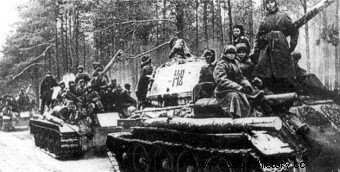
A column of Soviet tanks during the Vistula-Oder operation
Tanks, cannons and ammunition were delivered to the bridgeheads on the western side of the Vistula, captured by the Red Army in the summer of 1944. Supply lines, ammunition depots, fuel, field hospitals, staffs, communications and engineering and technical troops with specialized equipment were pulled up towards the river, separating the two fighting sides. Losses in "manpower" were also replenished, field airports were built and planes were transferred to them, and, of course, propaganda training was conducted. After all, it was necessary to prepare the soldiers of the Red Army to enter the area of "proklatoj germanii" (damned Germany) and what they find there.
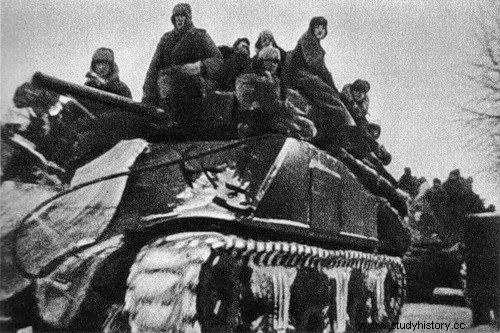
The Red Army 1945
Unless the front starts again…
On the Vistula River, from the estuary of the Narew River to Józefów, the troops of the 1st Belorussian Front prepared their attack for the attack, and from Józefów to Jasło, along the distance of 230 km, the engines of the 1st Ukrainian Front were firing. More than 2.2 million Soviet soldiers were ready to fight and "repay" the Germans who invaded their country. They were supported by 36,000 guns and mortars, 6,400 tanks and over 4,700 aircraft.
The scale of the preparations and the strength of the troops being gathered is evidenced by the "crowd" that reigned on the Magnuszew bridgehead, where 3 armies, 24 divisions and 5,300 guns were concentrated in a small area. The tanks were standing a dozen meters apart, and the operation was "wheel to wheel". It was a bit looser on the Puławy bridgehead, because "only" 16 divisions and 3,300 guns were stationed there. The Red Army was ready to attack and waited only for Stalin's orders. (Preparations for the offensive were signaled in the post-war series Czterej pancerni i pies. Recovering sergeant Czernousow explains to Jan Kos to Jan Kos that adding extra beds in the wards and discharging slightly wounded from the hospital means that the front will soon be launched. In this case, it was the January offensive - red note).
The Germans were not entirely convinced that Stalin would direct his troops by the shortest route to Berlin. They thought that he would first make offensives in the south to even the front lines. That is why they slowly and reluctantly expanded their defense system "beyond the Vistula" in the western territories of occupied Poland. However, despite technical and material difficulties, by January 1945 they had built as many as five lines of fortifications between the Vistula and the Oder. They stretched longitudinally from the Baltic Sea and ended only on the line of the Carpathians. Of great importance in the defense system were the "fortress cities", whose task was to "break the waves", i.e. frontal attacks by Red Army soldiers in jackets and with rifles on strings. But the Soviets no longer had rifles on strings, they wore good boots and warm uniforms, and their tanks and guns had unlimited ammunition ...
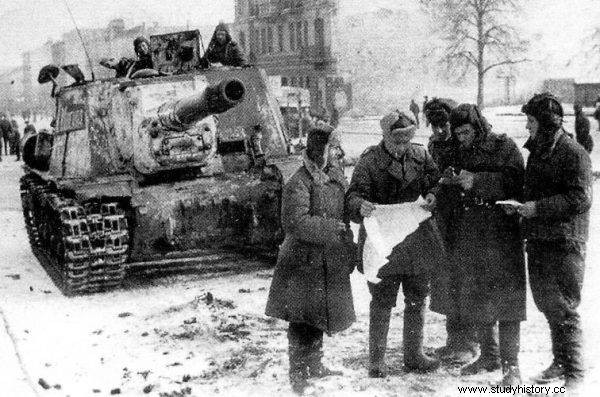
The Wisla-Oder operation is also called the "January Offensive"
On the maps and in the staff documents the German defensive lines looked powerful, but in fact they were a "shell" . Mostly because there weren't enough soldiers to fill them. Those few who were supposed to defend them were deprived of armored and artillery support. Hundreds of tanks and guns were lost in December in a last-ditch offensive in the west - in the Ardennes . Nevertheless, 400,000 German soldiers, supported by 4,000 soldiers, were preparing to defend the Vistula line. guns and about 1,000 tanks and armored guns. However, that was far too little.
The Führer always knows better
Hitler's most insightful general - Heinz Guderian (creator of the German armored doctrine) and the best informed - Reinhard Gehlen (commander of the OKH Fremde Heere Ost intelligence service - Foreign Armies East) warned their leader that the most serious threat was coming from the east. It was known that the operational pause required by the Russians to replenish the states and prepare the next major offensive would not last long. Gehlen even set a date for the commencement of the Soviet attack, announcing it for the second half of January 1945.
However, Hitler did not listen to these two "wise men" and other "defeatists" and acted bizarrely. He focused primarily on maintaining and strengthening the fronts distant from the Reich. He reacted hysterically to any offer of a tactical retreat and leveling the lines of defense. He wanted to defend Hungary at all costs and sent the strongest and best-armed armored units there, strengthened the defense of the Czech Republic and did not allow the withdrawal of the troops encircled in Courland. He ordered to keep Crete and the Greek islands, defend themselves in Yugoslavia and northern Italy, etc. He also did not take into account the possibility of bringing the occupation forces from Norway to the defense of the Reich, and they could significantly strengthen the battered Wehrmacht.
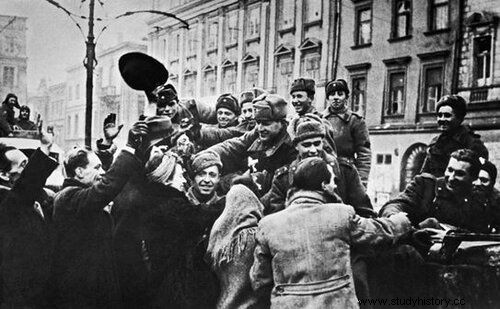
18/19 January 1945, Kraków
Hitler disregarded the Red Army standing on the Vistula River. He believed that she was weakened after months of offensive and she had lost too many people to be capable of further large operations. He ignored intelligence reports about the gigantic Soviet armaments production and the replenishment of combat units. He probably counted on the fact that his experienced, though few, divisions would be able to stop the Russian march on Polish territory and would fight defensive battles for many months.
At that time, he was going to throw the Americans and the English away from the western frontiers of the Reich and stabilize the western front. He also still counted on the production of weapons that would give Germany victory in the war. Hitler and his generals also hoped for a conflict and disintegration of the anti-Nazi coalition and the formation of an alliance of the Western Allies and Germany against the USSR. As we know, none of these visions came true.
Stalin on the map with the arrow pipe moved
On the other hand, Gehlen's forecast came true, and on January 12, the front moved from the Vistula River. The First Ukrainian Front started the great offensive. Gehlen misspelled her date, but his error can be explained by Stalin's order to expedite the operation. From December, Roosevelt and Churchill asked him for it, because American and British troops struggled to recover from the blows received in the Ardennes and were laboriously regaining the territory conquered by the Germans at that time.
On the other hand, the troops of the 1st Ukrainian Front, Marshal Ivan Koniew, who started the "first act" of the January offensive from the Sandomierz bridgehead on the Vistula, had no difficulties with conquering the area. After a short fight, they broke through the German first line and advanced 15 km. They trotted in place for a while, repelled the counter-strike of the 24th Panzer Corps, but on January 14 they entered the operating space and rushed forward. On January 17, they crossed the Warta River and captured Częstochowa, on January 18, they liberated Piotrków Trybunalski, and on January 19, after short fights, they took Krakow (taking advantage of the fact that the Germans had withdrawn). In 6 days, Koniew's army covered 160 km!
Meanwhile, on January 14, the attack of the 1st Belorussian Front was launched from the Puławy bridgehead, which was to carry out the second act of the operation. On the first day, Marshal Zhukov's troops pierced the first line of German defense to a depth of 12-18 km, and on the second day they covered another 20 km. On January 15, the 47th and 61st Army outflanked Warsaw . The First Polish Army, which took over the ruined capital on January 17, entered the fight. The fights for the city were short-lived, because there were only a few protective troops in Warsaw. The Germans withdrew most of their troops for fear of being encircled.
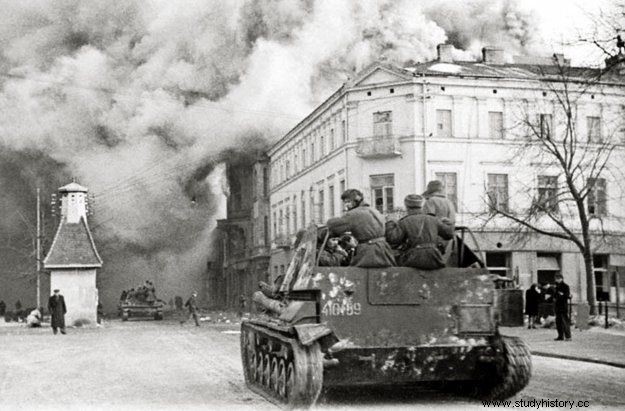
The entry of the Soviet army into Warsaw in January 1945. Art Print Marek Skorupski
The main grouping of the Belorussian Front repelled the German counterattack (40th Panzer Corps) and opened its way to the west. Now also Zhukov's armored fields broke forward and began to roll the German defense. Small German groups, reserve forces and barrier units were broken up on the march. As early as January 19, the Russians captured Łódź, Kutno and Tomaszów Mazowiecki, on January 20 they captured Koło, and 21 Gniezno . The first serious obstacle turned out to be Poznań, which they reached on January 22. The pace of the Soviet attack was incredible. From the initial 25-30 km / day, the Russians went up to 80 km / day! The supply services had huge problems keeping up with the strike units. (One of the units of the 5th Shock Army traveled 370 km in five days. It used up all the ammunition and fuel, so it had to stop for two days.)
Germany is not keeping up
The first days of the offensive showed how much the Soviet commanders learned from the Germans. They used the maneuvers that were applied to them in 1941 in Operation Barbarossa . The armored units did not stop to break up encircled German groups, but pressed forward, wreaking havoc and destruction in the deep rear. The weather conditions (for the Red Army) were favorable for the fast pace of the attack. The operation took place in flat, lowland areas of central Poland, where small rivers were the only natural obstacles. It was quite cold (-10 to -15 degrees) but the snow cover was thin. This allowed the armored units to attack at a fast pace and to march across wetlands (swamps, backwaters) that they could not pass in spring, summer or autumn.
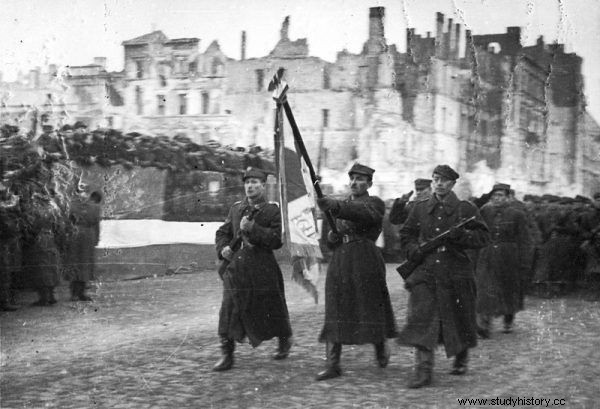
Parade of the 1st Polish Army on Marszałkowska Street in liberated Warsaw, January 19, 1945
Both sides - the retreating Germans and the attacking Russians tried to cross rivers and lakes on the frozen ice. It was not always successful. Many German vehicles sank in Pilica, others fell under the ice in the backwaters and oxbow lakes of the Warta in Greater Poland. Wrecks found in recent years in these areas, e.g. the StuG IV excavated in 2008 from the Rgielewka river in Grzegorzewo near Koło, or the SdKfz 6 found in 2011 near Pyzdry, these are the remains of the German retreat in January 1945.
The Germans also learned a lot in the East. They were able to withdraw in an organized manner, stopping or slowing down Soviet attacks for a long time. This time it was completely unsuccessful . During the January offensive, the broken troops did not retreat - as it used to be - to "predetermined positions" . Soldiers usually abandoned their heavy equipment and retreated west in panic, only to be captured after a few days. The marauders were disarmed and seized by rear protection units, because the Soviet armored headlamps were already 100 or 200 kilometers away.
Only in one case was there a reasonably successful retreat. At the junction of the Soviet fronts there was a population of around 100,000. soldiers of General Walther Nehring commanding the 24th Panzer Corps. Nehring, who was coming from Kielce, was joined by the crashed units of the 40th Corps of General Herman Recknagel. This "traveling cauldron" was retreating westwards towards the Oder for many days, fighting constantly against the Russians. The 16th Panzer Division, whose task was to break through the Soviet lines and open a passage for units following behind, was on the spearhead. It should be noted that the Russians did not disturb Nehring too much, because they were busy with something else ... Finally Nehring's group reached the German lines on the Oder at the end of January, and some of its soldiers strengthened the crew of the "Głogów Fortress" preparing to defend themselves on the way. .
Forward, keep on moving!
The main task of the units of both Soviet fronts was to break up the German forces and break into their defensive lines as deep as possible. The Soviets already knew that the Germans were able to retreat to a depth of several dozen kilometers and re-create lines of defense, which then had to be conquered in many days of bloody fights. Experienced Soviet commanders ordered their soldiers to rush forward and not to allow themselves and the Germans even a moment to breathe.
The adoption of such a strategy prevented the Germans from effectively using the "fortress city" system . They formed one of many lines of defense running from the north to the south of Poland. It included, among others the fortresses of Grudziądz, Piła, Poznań, Głogów, Wrocław and Nysa. According to the assumptions, large cities, fortified and reinforced with artillery and tanks, were to stop Soviet attacks for many weeks. Hitler expected the Russians to decide to surround the fortress cities and conquer them in long, bloody street fights . He knew that under favorable conditions, a few or a dozen thousand strong fortress personnel could defend themselves for weeks, tying up several times greater besieging forces in combat. This clever idea was only partially successful during the January offensive. The Russians encircled and captured large cities, but they continued their attack to the west, leaving the German garrisons behind. In the case of Poznań, they set up three divisions to fight, but the main forces of the front kept going.
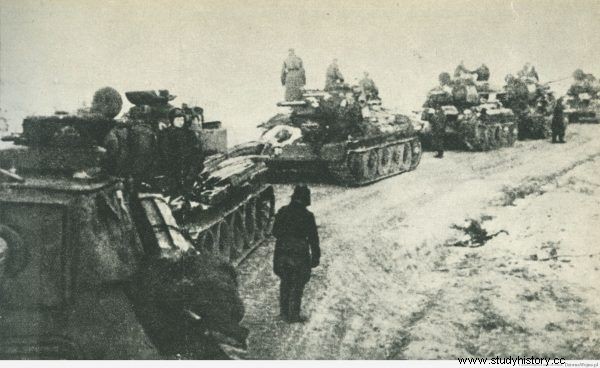
Centering the tanks of the 1st Armored Brigade before the Warsaw operation.
The success in the attack and the very fast pace were maintained by the units of both fronts:Ukrainian and Belarusian. On January 19, Koniew's troops captured Lubliniec, and on January 21 they reached the outskirts of Wrocław and reached the Odra river. The battle to capture the other bank began, as a result of which, on January 24-26, four bridgeheads were captured in the area of Ścinawa, Prochowice, Oława, Brzeg and Opole.
Meanwhile, on January 27, Żuków's troops attacked through Greater Poland reached the pre-war Polish-German border and entered the territory of the Third Reich. The next obstacle was to be the huge fortifications of the Międzyrzecz Fortified Region. The Soviets knew about them from intelligence reports and expected that breaking the fortifications would be very difficult. However, they were lucky. A unit of the 1st Guards Tank Army got through the gap in the central section of the MRU, before it was secured by the Germans. This breach was made by the avant-garde battalion of the 44th Armored Guards Brigade commanded by Major Alexei Karabanov.
In the dark, the sappers removed the metal rails blocking the road, secured on both sides with "dragon teeth", which allowed for the introduction of the tanks into the fortification system. The Germans realized quickly what had happened and secured the breach. The 45th Brigade, following from the rear, did not surprise the Germans anymore, it "bounced" from the fortifications and had to conquer them by fighting several days of heavy fighting and performing circling maneuvers. It turned out that the fortifications built at great cost were not fully manned, and if they were, their crew were weak and inexperienced Volkssturm units and not appropriately trained fortress battalions intended for such purposes. Let us add that the defense along the MRU line was to be manned by the 5th SS Mountain Infantry Corps, which was just being transferred to the Oder river from… Yugoslavia. Eventually the MRU line was captured on January 30th and 31st.
To the Odra River on the last drops of fuel ...
The pace of the attack was lethal not only for the Germans, but also for the Soviet supply units. When the Russians reached the Odra River, the supply depots were still behind the Vistula, so almost 500 km behind. The supreme goal of the Red Army, however, was to move forward, so unconventional solutions were used.
The separated unit of the 5th Shock Army, whose task was to gain a foothold near Kienitz, ran out of fuel 15 km before the river. From the separated unit (5th Strike Army), an even smaller strike force was separated, consisting of tanks, infantry on trucks and artillery. He was given fuel by tanks and cars, which were to stop and wait for supplies to be delivered. On January 31, the Soviet Spitz reached the Odra River and crossed the river on ice, creating a bridgehead. Until April 1945, this and the other bridgeheads captured in the following days were fiercely attacked by the Germans and hardly defended by the Red Army. They were then used to make a decisive thrust into the heart of the Third Reich - the storming of Berlin.
During the January offensive, the supply of supplies was provided by trucks, because rail traffic had not yet been restored. In order to improve deliveries and reduce fuel consumption, "car trains" were created. The trucks going across the Vistula for supplies were empty, so they were light. One truck, with a full tank of fuel, was towing two more, which were not refueled, and thus - saving fuel - the "convoy" went east. There were many accidents, because tired drivers of towed trucks fell asleep while driving. The scale of the needs is evidenced by the fact that the troops of both fronts used 245 wagons of ammunition and over 4,000 tons of fuel.
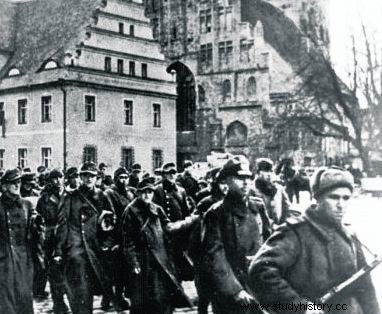
Lubsko, 1945. The march of a column of German prisoners of war escorted by soldiers of the Red Army.
The January offensive, also known as the Vistula-Oder operation, ended on February 3, so it lasted only three weeks. It stopped when the troops of the two fronts reached the Oder. From January 12, the Soviet troops made a jump of 400-500 kilometers, showing an efficiency that had not been seen before during the Second World War. The average pace of the infantry attack was 25 km per day, and the armored units "rushed" ahead, gaining up to 35 km of terrain per day. If we take into account that the Soviet troops fought against the retreating Germans, broke through their deep defenses, captured cities defended with great forces, and even broke through powerful lines of fortifications, this feat can be considered extraordinary.
As mentioned earlier, these achievements were favored by strategic circumstances. Until mid-January, the Germans did not realize that they were dealing with a major offensive operation and were too slow in taking decisions to include fresh and strong units in the fight. The German armies defending the front lines, which were supposed to stop the Russians on the Vistula River, were too weak and immediately disintegrated. The lines of defense behind them were symbolic, as no one was defending them. For the 1st Guards Armored Army of Gen. Katukow, advancing through the center of Poland, the first serious obstacle in the attack from Warsaw turned out to be the Poznań Fortress. The 300 km separating these two cities were rushed by the Russians, almost as if they were taking the A2 motorway.
The next jump, 200 km to the Odra River, was a bit more difficult, but not because of the tightening German defense, but because the supply lines were excessively lengthened and the offensive had to be stopped due to lack of fuel, ammunition, food, spare parts. The great depth of the attack also made it difficult for the air force, which was still stationed on the Vistula River . So the airports had to be moved closer to the front and the planes had to be ferry. First, however, the conquered area had to be cleared of remnants, conquered the besieged cities and secured the front on the wings.
Stalin was particularly concerned about the "Pomeranian overhang", ie the territories of East Prussia, Central and Western Pomerania, where there was a strong and as yet undisturbed German grouping. They had to be destroyed before starting the storming of Berlin. Meanwhile, OKW Oberkommando des Heeres (Supreme Command of Land Forces), commanding troops on the Eastern Front, wanted to stop the attack on Berlin. Therefore it recognized the Oder as the most important line of defense and did everything to strengthen it. First of all, on the explicit order of Hitler, it ordered the fortress cities of Wrocław, Głogów, Frankfurt, Kostrzyn and Szczecin to be defended at all costs and to the end. It also transferred all available divisions to the Oder front:from the Western Front and the Italian Front, and also created "paper" divisions with several thousand soldiers (instead of the statutory 16 thousand), equipping them with several dozen tanks, instead of several hundred.
The tiger, which was the Third Reich, was dragged to the corner of the cage with the last of its strength. He might snarl and scratch his claw a few more times, but these were agonal movements.
